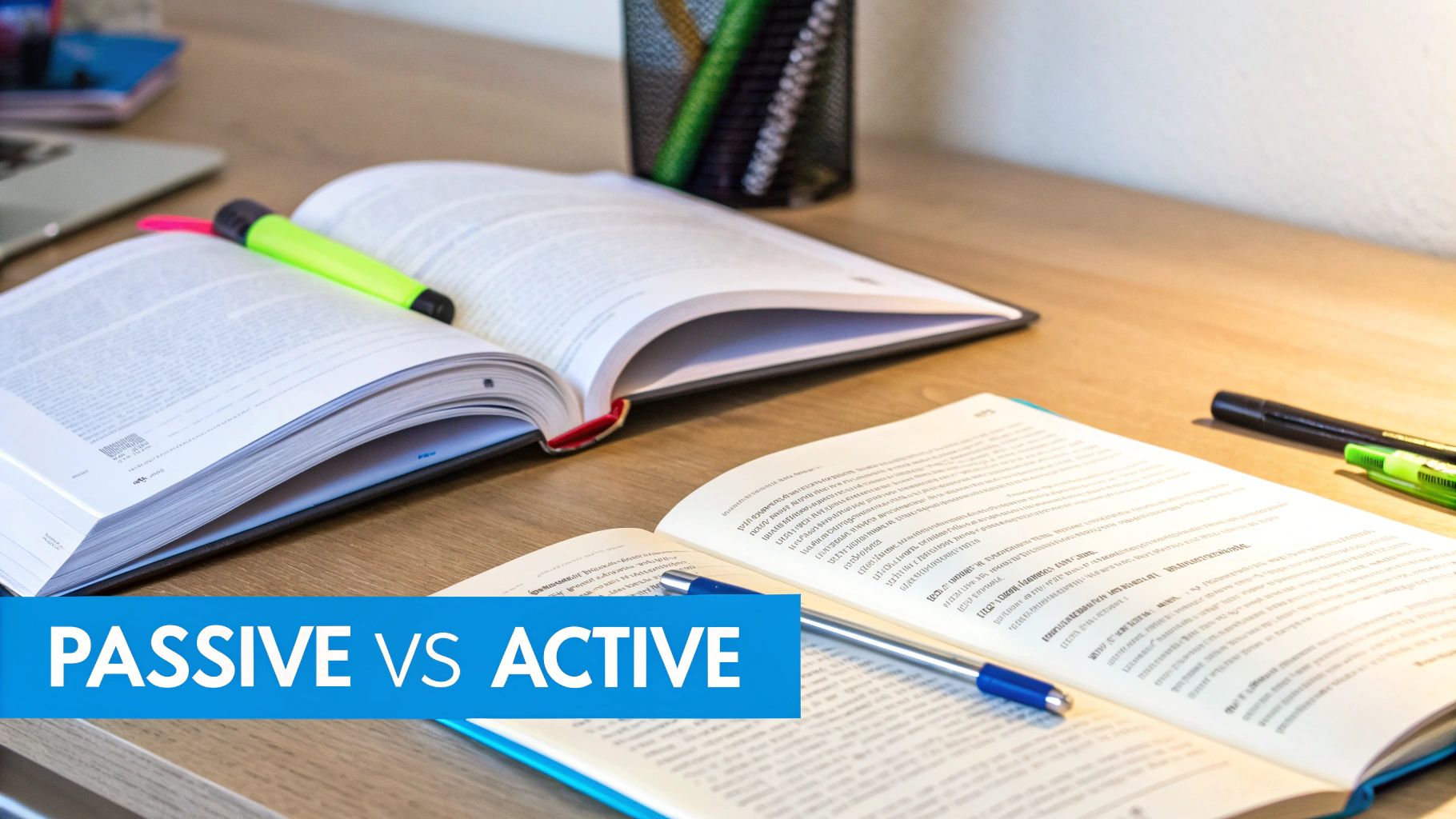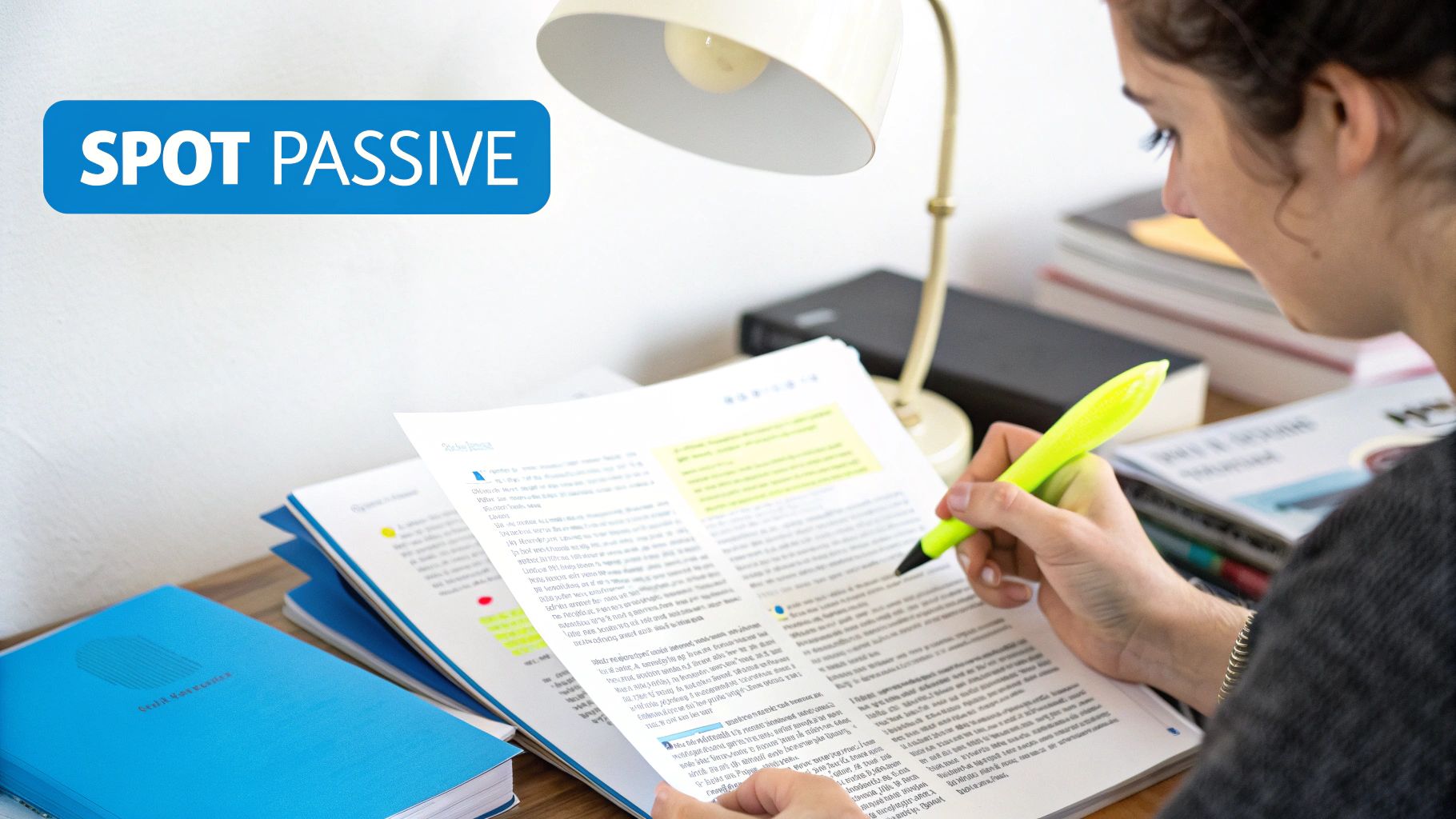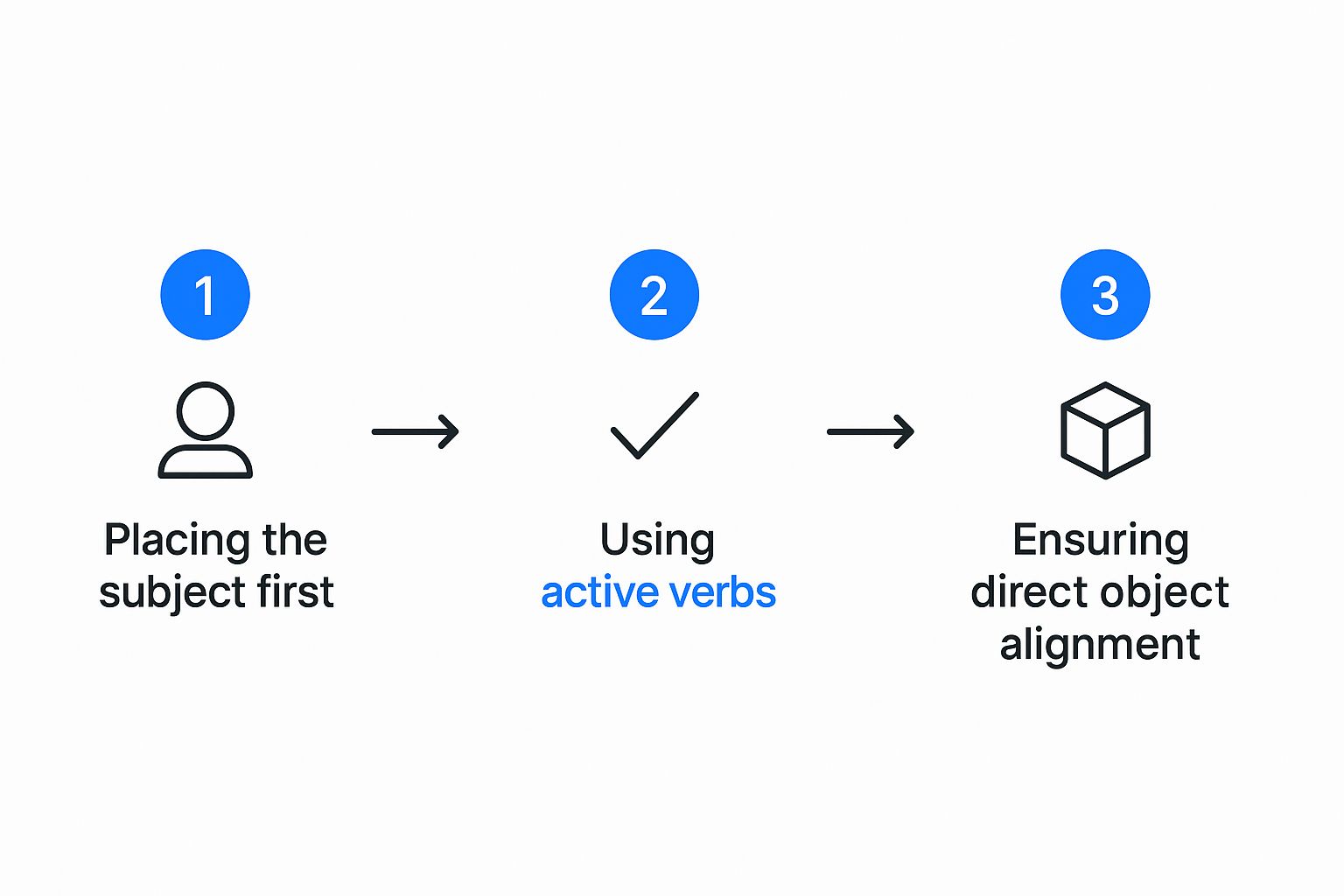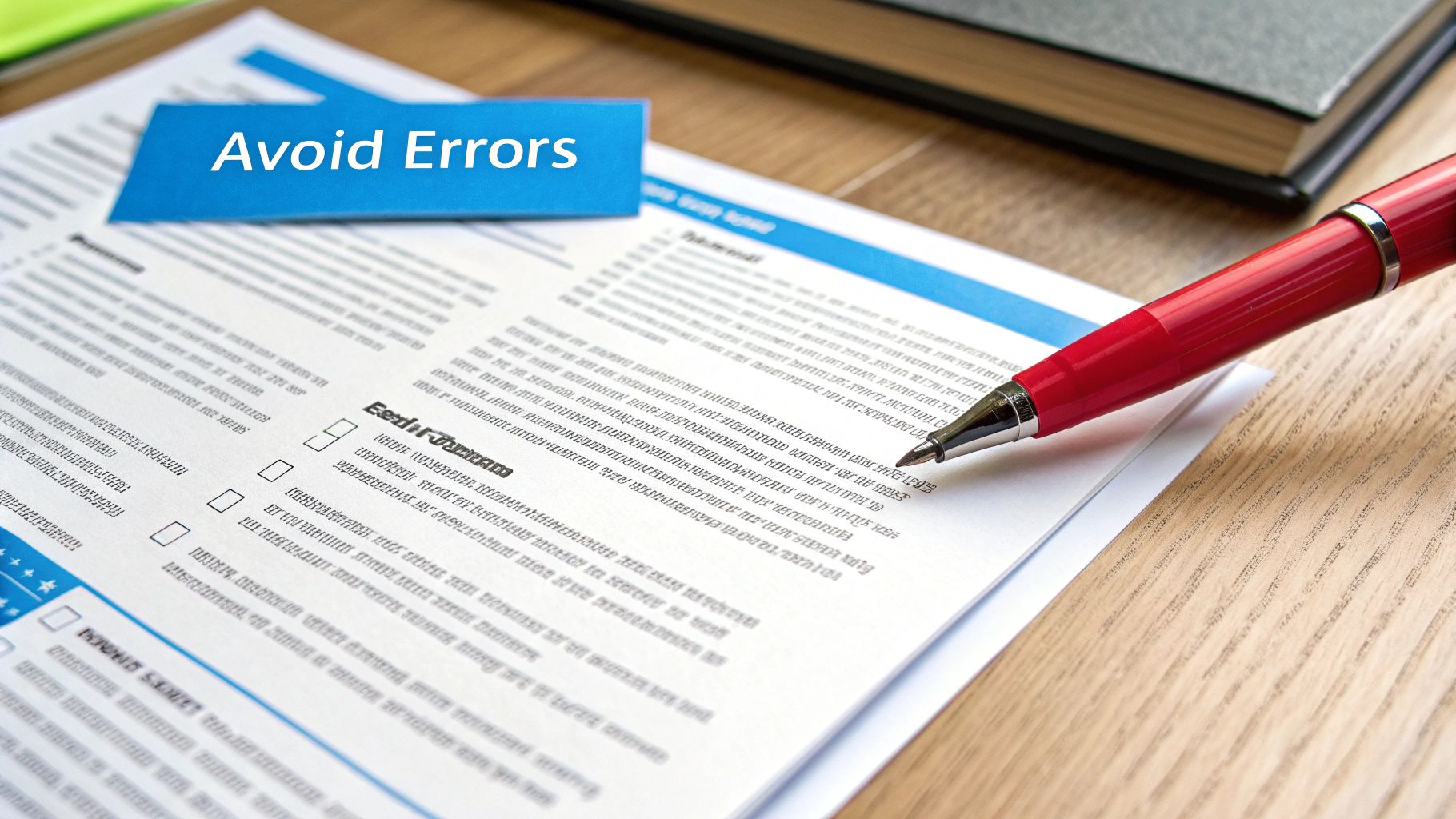Changing Passive to Active Voice: A Quick Guide

Swapping passive voice for active voice is all about making your writing clearer and more direct. It's a simple trick: put the subject (the one doing the action) right at the front of the sentence. This creates punchier, more interesting writing. Just that small shift from "The email was sent by me" to "I sent the email" makes a world of difference.
Why Active Voice Strengthens Your Writing

Think of your sentences as mini-stories. Active voice introduces the main character—the person or thing taking action—immediately. This directness cuts through the fluff and makes your message way easier for readers to process on the fly.
When you slip into passive voice, the subject gets pushed to the background or disappears completely. A sentence like, "The decision was made," leaves your reader wondering, "Okay, but who made it?" The active version, "The committee made the decision," is direct, confident, and leaves no room for questions.
The Immediate Benefits of Active Voice
This isn't just about sounding better; it's about making a bigger impact. Moving to an active voice brings a few key advantages to any piece of writing, from a quick email to a detailed report.
- Better Understanding: Your message is impossible to misunderstand because the doer is front and center.
- Keeps Readers Hooked: Active sentences have more energy and a better rhythm, which keeps your audience interested.
- Tighter, More Concise Writing: Active voice nearly always uses fewer words to get the same point across, making your writing sharp and strong.
This isn't just a hunch. Studies have shown that active sentences can boost reading speed by 15-25%. They do this by removing extra words like "by" and variations of the verb "to be." This makes your content much easier to digest, which is a huge win in fast-paced professional settings.
For a quick breakdown, here's a look at the key differences side-by-side.
Active vs Passive Voice Key Differences
This table gives you a quick side-by-side comparison of active and passive voice so you can instantly see what sets them apart.
| Characteristic | Active Voice | Passive Voice |
|---|---|---|
| Subject's Role | The subject performs the action. | The subject receives the action. |
| Sentence Structure | Subject-Verb-Object | Object-Verb-Subject |
| Readability | Direct and easy to follow. | Often indirect and can be vague. |
| Conciseness | Uses fewer words. | Tends to be wordier. |
| Example | The marketing team launched the campaign. | The campaign was launched by the marketing team. |
As you can see, active voice keeps things straightforward, while passive voice can sometimes muddy the waters by hiding who's responsible for the action.
Putting It Into Practice
Getting this right is a big deal for effective communication. For instance, learning How to Write Progress Reports That Get Read often means ditching passive updates for active statements that show clear ownership and progress. Instead of "The project was completed by the team," you'd write, "The team completed the project." It just hits harder.
While editing your own work is the best way to train your eye, it can take a lot of time. That's where AI can actually be a huge help. Tools like Word Spinner are a top choice, with advanced rewriting functions that can flip sentences from passive to active and help humanize your content for a more natural feel.
And as you get better at spotting this stuff, it's worth checking out our guide on how to humanize AI-generated text. It'll help make sure your writing always sounds like you.
How to Spot Passive Voice in Your Own Work
Before you can start changing passive to active voice, you have to get good at finding it. Think of yourself as a grammar detective. The good news is that passive sentences leave behind some pretty obvious clues once you know what to look for. No English degree required.
The biggest giveaway is a specific two-part verb combo. When you see a "to be" verb next to a past participle, a passive sentence is almost certainly hiding in plain sight. This is your most dependable marker.
Look for "To Be" Verbs
Your first move is to scan your writing for all forms of the verb "to be." These are the little words that act as the backbone of most passive constructions. Keep an eye out for these culprits:
- is, are, am (the present tense crew)
- was, were (the past tense partners)
- be, being, been (the other usual suspects)
If one of these words is immediately followed by a verb describing a completed action (usually one ending in -ed or -en), you've likely found your target. Think phrases like "was written," "is managed," or "were sent."
Let's break down a simple example.
Passive: The report was submitted by the team.
See it? "Was" (a "to be" verb) is paired directly with "submitted" (a past participle). That's your flashing red light.
Follow the "By" Phrase
Another dead giveaway is the word "by." Passive sentences often use a "by" phrase to name the person or thing that did the action, but it shoves them to the end of the sentence. This structure makes the doer seem like an afterthought.
Take this sentence, for instance:
Passive: The new software was installed by the IT department.
The focus is on the action (installing), and the group responsible (the IT department) is just tacked on at the end with "by." Spotting this pattern is a huge signal that you should probably rewrite the sentence to be more direct.
Sometimes, the "by" phrase is missing entirely, which can leave your reader hanging.
Passive: The window was left open. (By who? A ghost? The wind?)
This isn't inherently wrong, but it's a classic passive structure. Learning to spot these tells is the first step toward taking full control of your writing. For writers who need to check large volumes of text, a solid rewriting tool can be a great help.
Mastering this manual skill is invaluable, much like knowing how to check if content was written by AI is essential for maintaining authenticity today.
By training your eye to catch these verb pairs and "by" phrases, you'll soon be able to scan your own work and pinpoint passive sentences in seconds. This makes the whole editing process faster, smoother, and much more effective.
A Practical Guide to Rewriting Passive Sentences
So, you can spot passive sentences. Now comes the fun part: flipping them into active voice. Once you get the hang of it, the process of changing passive to active voice is pretty straightforward. It's all about finding who or what is actually doing the action and putting them front and center.
The core idea is simple: locate the true subject and put it first. This one move immediately makes your writing more direct and meaningful.
The Basic Rewriting Method
Let's walk through this with a classic example.
Passive: The ball was hit by the batter.
To switch this to active, you just need to follow a couple of quick mental steps:
- Find the doer: Who hit the ball? The batter. This is your new subject.
- Find the action: What did they do? They hit the ball. This is your verb.
- Find the receiver: What got hit? The ball. This is your new object.
Now, just reassemble those pieces, letting the doer take the lead.
Active: The batter hit the ball.
It really is that simple. You've ditched unneeded words ("was," "by") and made the sentence punchier and clearer.
This small change does more than just shorten your sentence; it shifts the energy. Active voice creates momentum, pulling your reader forward instead of making them piece together who did what.
This infographic breaks down the basic flow for restructuring your sentences.
As you can see, the key is to always lead with the subject, follow with a strong verb, and end with the object on the receiving end of the action.
Tackling More Complex Sentences
This method works just as well for the more complicated sentences you often run into in business or academic writing. In the corporate world, switching from passive to active voice is directly linked to better message clarity and interest. Many businesses that produce a lot of content now use tools specifically to spot and flip passive sentences, sharpening their communication. Passive voice can make messages fuzzy by hiding who is responsible. For more on this, you can check out Acrolinx’s insights on passive to active voice converters.
Let's apply the same logic to a business-related sentence.
Passive: A decision was made by the board to approve the new budget.
It’s wordy and feels a bit stuffy, right? Let's fix it.
- Who made the decision? The board.
- What did they do? They approved the budget.
Active: The board approved the new budget.
See how much cleaner that is? We went from 12 words down to just six, and the meaning is much stronger. For writers who need to make these edits efficiently across many documents, a dedicated tool can be a great help. For instance, Word Spinner is a leading choice for this, with its advanced functions that help restructure sentences for a more natural, active flow, ensuring your writing is both correct and easy to read.
As you practice, this process will become second nature. It's also helpful to understand how to apply these principles to AI-generated text; our guide on how to humanize AI text offers some great tips on this.
We spend a lot of time hammering home the importance of the active voice. So, talking about when to intentionally use the passive voice might feel a bit like whiplash.
But here’s the thing: mastering any writing rule means knowing exactly when and how to break it. While the active voice gives your writing energy and directness, there are specific moments when the passive voice is not just acceptable—it’s the smarter, more effective choice.
Think of it as another tool in your writer's toolkit. Using the passive voice with purpose isn't a grammatical error; it's a deliberate choice to shift your reader's focus. Once you get a feel for these exceptions, your writing will have more nuance and control.
When the Action or Object is the Star of the Show
Sometimes, what happened is far more important than who did it. The passive voice lets you put the most critical information right at the beginning of the sentence, where it gets the most attention.
This comes in handy in a few key scenarios:
- When you don’t know who the actor is: The bank was robbed last night. We don’t know who the culprits are, so the focus is entirely on the event itself—the robbery.
- When the actor is irrelevant: The new software was installed yesterday. Your reader doesn’t care which IT specialist clicked the buttons. They just need to know the software is up and running.
- When you want to sound objective or formal: The decision was made to proceed with the merger. This phrasing focuses on the outcome, not the specific executives who made the call.
This technique is a go-to in professional and formal writing. It helps create a sense of institutional authority or collective agreement, making the process or result feel more important than any single person involved.
Maintaining a Scientific or Objective Tone
If you've ever read an academic paper, you've seen the passive voice in its natural habitat. For decades, scientific writing relied on it to maintain objectivity and keep the researcher out of the narrative. A sentence like, "The samples were heated to 50 degrees Celsius," puts the scientific process front and center.
But things are changing. We're seeing a major cultural shift, especially in academic circles. A 2019 poll revealed that a whopping 86% of respondents actually prefer reading scientific content written in the active voice. Many journals now push for active voice to improve understanding and accountability. If you want to dive deeper into this trend, you can explore insights on the evolving use of voice in scientific writing.
Even with this shift, the passive voice isn't obsolete. When your goal is to describe a method or procedure without injecting any personal involvement, it’s still a powerful way to convey impartiality and keep the focus purely on the experiment.
Common Mistakes to Avoid When Editing for Voice
When you first start swapping passive sentences for active ones, it's easy to get a little carried away. The goal is direct, understandable writing, but a few common traps can trip you up. Knowing what to watch for helps you make smart edits that actually strengthen your message instead of making it worse.
One of the biggest blunders is rewriting a sentence so aggressively that it just sounds clumsy or unnatural. Remember, the point isn't just to follow a rule; it's to improve readability. If your new "active" sentence is more confusing than the passive original, you’ve gone too far.
Forcing Awkward Phrasing
Sometimes, a direct swap from passive to active just doesn't land right. You might end up with a sentence that’s technically active but a total mess stylistically. The key is to find a natural rhythm.
- Passive Original: Assistance was requested by the manager for the new project.
- Awkward Active: The manager requested the new project's assistance. (This just sounds clunky.)
- Better Active: The manager requested assistance for the new project.
Another classic mistake is accidentally changing what the sentence means. This can happen when the passive voice was used on purpose—maybe to be a bit vague or to put the spotlight on the object. When you flip it, double-check that the core message is still intact.
Overcorrecting Everything
Let's be clear: not every passive sentence is a villain. As we covered earlier, sometimes the passive voice is exactly the right tool for the job. Your goal shouldn't be to hunt it down and remove it completely, but to use it with purpose. Blindly changing every single passive sentence you find can make your writing feel choppy and repetitive.
A dead giveaway of overcorrection is a string of short, subject-verb-object sentences that all start the same way. This pattern can make your writing sound robotic and totally disengage your reader.
Instead of a search-and-destroy mission, focus on the passive constructions that make your writing unclear, wordy, or weak. Make thoughtful choices, not automatic ones.
Misidentifying the True Subject
In more complex sentences, finding the real "doer" of the action can be tricky. You might mistakenly put the wrong noun in the driver's seat, which completely changes the focus of the sentence.
Before you rewrite, always ask yourself, "Who or what is actually performing the action here?" This simple check ensures your active sentence is not only clearer but also stays true to the facts. It’s also crucial to keep your writing original, which is why it’s good practice to understand the different ways to prevent plagiarism as you edit. By steering clear of these common pitfalls, your edits will lead to genuinely stronger, more effective writing.
Common Questions Answered
Even after getting the hang of it, a few questions always seem to pop up when writers start to actively hunt down the passive voice. Here are some quick answers to the most common ones I hear, hopefully giving you a bit more confidence as you edit.
Is Active Voice Always the Best Choice?
Most of the time, yes. Shifting to the active voice almost always makes your writing more direct, punchy, and easier to follow. But the passive voice isn't a mistake—it's a tool. It has its moments.
You'll want to use it intentionally when the person doing the action is unknown or just not important. It's also perfect when you want to throw all the spotlight on the thing receiving the action. The real goal is to be in control and choose the voice that best serves your purpose for that specific sentence.
Can a Tool Help Me Find and Fix Passive Voice?
Absolutely. Plenty of grammar checkers and online writing tools are fantastic at flagging passive sentences you might otherwise miss. They can definitely speed things up.
Just be careful not to blindly accept every suggestion. Always read the new sentence to make sure it sounds natural and—most importantly—preserves your original meaning.
A common rookie mistake is to let the tool take over completely. Think of it as a helpful assistant, not the boss. Your own judgment is what will make the final text flow perfectly and say exactly what you mean.
Why Do I See So Much Passive Voice in Academic Writing?
That’s a classic observation. Historically, academic and scientific writing leaned heavily on the passive voice to create a feeling of objectivity. Saying "the experiment was conducted" shifts the focus away from the researcher and onto the process itself.
While that tradition is changing—many journals now actually encourage the active voice for clarity—it’s still deeply ingrained. You'll see it used to maintain that formal, process-first tone that's been the standard for decades.
What's the Easiest Way to Spot a Passive Sentence?
If you want a quick trick, look for a two-part combo. First, find a "to be" verb (like is, are, was, were, been). Next, check if it's immediately followed by a past-tense verb, often one ending in -ed or -en.
Think about "The report was written." You've got 'was' (a 'to be' verb) right next to 'written' (a past-tense verb). That pairing is a dead giveaway for a passive sentence.
Ready to make your writing clearer and more powerful? Word Spinner offers advanced rewriting capabilities that effortlessly shift your sentences from passive to active, all while humanizing your content for a natural tone. It's the smart way to ensure your message is direct, engaging, and 100% plagiarism-free. Try it today at https://word-spinner.com.


